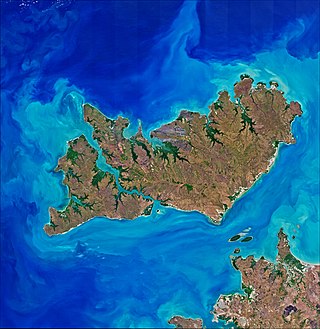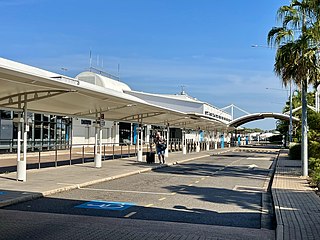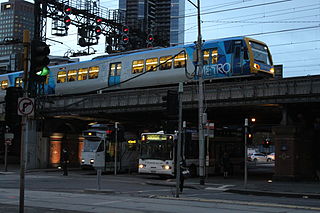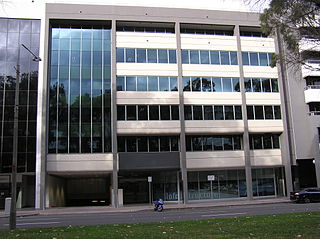Related Research Articles

Education in Australia encompasses the sectors of early childhood education (preschool) and primary education, followed by secondary education, and finally tertiary education, which includes higher education and vocational education. Regulation and funding of education is primarily the responsibility of the States and territories; however, the Australian Government also plays a funding role.

Chloe, also spelled Chloë, Chlöe, or Chloé, is a feminine name meaning "blooming" or "fertility" in Greek. The name ultimately derives, through Greek, from the Proto-Indo-European root *ǵʰelh₃-, which relates to the colors yellow and green. The common scientific prefix chloro- derives from the same Greek root. In Greek the word refers to the young, green foliage or shoots of plants in spring.

Highways in Australia are generally high capacity roads managed by state and territory government agencies, though Australia's federal government contributes funding for important links between capital cities and major regional centres. Prior to European settlement, the earliest needs for trade and travel were met by narrow bush tracks, used by tribes of Indigenous Australians. The formal construction of roads began in 1788, after the founding of the colony of New South Wales, and a network of three major roads across the colony emerged by the 1820s. Similar road networks were established in the other colonies of Australia. Road construction programs in the early 19th century were generally underfunded, as they were dependent on government budgets, loans, and tolls; while there was a huge increase in road usage, due to the Australian gold rushes. Local government authorities, often known as Road Boards, were therefore established to be primarily responsible for funding and undertaking road construction and maintenance. The early 1900s saw both the increasingly widespread use of motorised transportation, and the creation of state road authorities in each state, between 1913 and 1926. These authorities managed each state's road network, with the main arterial roads controlled and maintained by the state, and other roads remaining the responsibility of local governments. The federal government became involved in road funding in the 1920s, distributing funding to the states. The depression of the 1930s slowed the funding and development of the major road network until the onset on World War II. Supply roads leading to the north of the country were considered vital, resulting in the construction of Barkly, Stuart, and Eyre Highways.
Local government is the third level of government in Australia, administered with limited autonomy under the states and territories, and in turn beneath the federal government. Local government is not mentioned in the Constitution of Australia, and two referendums in 1974 and 1988 to alter the Constitution relating to local government were unsuccessful. Every state/territory government recognises local government in its own respective constitution. Unlike the two-tier local government system in Canada or the United States, there is only one tier of local government in each Australian state/territory, with no distinction between counties and cities.

Dangerous goods (DG), are substances that are a risk to health, safety, property or the environment during transport. Certain dangerous goods that pose risks even when not being transported are known as hazardous materials. An example for dangerous goods is hazardous waste which is waste that has substantial or potential threats to public health or the environment.

The Tiwi Islands are part of the Northern Territory, Australia, 80 km (50 mi) to the north of Darwin adjoining the Timor Sea. They comprise Melville Island, Bathurst Island, and nine smaller uninhabited islands, with a combined area of 8,320 square kilometres (3,212 sq mi).

Darwin International Airport is a domestic and international airport, and the only airport serving Darwin, Australia. It is the eleventh busiest airport in Australia measured by passenger movements.
The James Bay and Northern Quebec Agreement is an Aboriginal land claim settlement, approved in 1975 by the Cree and Inuit of northern Quebec, and later slightly modified in 1978 by the Northeastern Quebec Agreement, through which Quebec's Naskapi First Nation joined the agreement. The agreement covers economic development and property issues in northern Quebec, as well as establishing a number of cultural, social and governmental institutions for Indigenous people who are members of the communities involved in the agreement.

Australian Maritime Safety Authority (AMSA) is an Australian statutory authority responsible for the regulation and safety oversight of Australia's shipping fleet and management of Australia's international maritime obligations. The authority has jurisdiction over Australia's exclusive economic zone which covers an area of 11,000,000 square kilometres (4,200,000 sq mi). AMSA maintains Australia's shipping registries: the general and the international shipping registers.

Transport in Melbourne, the state capital of Victoria, Australia, consists of several interlinking modes. Melbourne is a hub for intercity, intracity and regional travel. Road-based transport accounts for most trips across many parts of the city, facilitated by Australia's largest freeway network. Public transport, including the world's largest tram network, trains and buses, also forms a key part of the transport system. Other dominant modes include walking, cycling and commercial-passenger vehicle services such as taxis.

The Department of Infrastructure, Transport, Regional Development and Cities was an Australian Public Service department of the Government of Australia that existed between December 2017 and May 2019, charged with the responsibility for infrastructure and major projects, transport, local government, external territories administration, rural and regional development, population policy, and cities.
Speed limits in Australia range from 5 km/h (3.1 mph) shared zones to 130 km/h (81 mph). Speed limit signage is in km/h since metrication on 1 July 1974. All speed limits, with the sole exception of the South Australian school and roadworks zones, which are signposted at 25 km/h, are multiples of 10 km/h – the last digit in all speed signs is zero. Speed limits are set by state and territory legislation albeit with co-ordination and discussion between governments.

The Australian Transport Safety Bureau (ATSB) is Australia's national transport safety investigator. The ATSB is the federal government body responsible for investigating transport-related accidents and incidents within Australia. It covers air, sea and rail travel. The ATSB is an independent Commonwealth Government statutory agency, governed by a Commission and is separate from transport regulators, policy makers and service providers.
The Environment, Planning and Sustainable Development Directorate (EPSDD) is a directorate of the Australian Capital Territory government. It was formed from the merger of the Department of Environment, Climate Change, Energy and Water (DECCEW) and the ACT Planning and Land Authority (ACTPLA) on 17 May 2011, after Katy Gallagher was elected by the Legislative Assembly as Chief Minister the day before.

The Minister for Infrastructure, Transport, Regional Development and Local Government in the Government of Australia is a position currently held by Catherine King following the swearing in of the full Albanese ministry on 1 June 2022.
The city of Hobart, Tasmania is served by a wide variety of transport. While the city's main form of transport is private transport on the road network, transport is also available by bus, ferry and aircraft. A suburban train service operated between Hobart and Brighton from the 1870s until 31 December 1974. There has been, however, talk in recent years of reinstating a train service in the northern suburbs.
Cycling in Australia is a common form of transport, recreation and sport. Many Australians enjoy cycling because it improves their health and reduces road congestion and air pollution. The government has encouraged more people to start, with several state advertising campaigns aimed at increasing safety for those who choose to ride. There is a common perception that riding is a dangerous activity. While it is safer to walk, cycling is a safer method of transport than driving. Cycling is less popular in Australia than in Europe, however cyclists make up one in forty road deaths and one in seven serious injuries.

Australia was the first country to make wearing bicycle helmets mandatory. The majority of early statistical data regarding the effectiveness of bicycle helmets originated from Australia. Their efficacy is still a matter of debate.

The Department of Infrastructure and Transport was an Australian government department. It was formed in September 2010, following the federal election in August 2010. The department absorbing parts of the Department of Infrastructure, Transport, Regional Development and Local Government. Regional development and local government functions were sent to the Department of Regional Australia, Regional Development and Local Government. Following the 2013 federal election, the department was renamed on 18 September 2013 to become the Department of Infrastructure and Regional Development, regaining regional development and local government functions.

The Department of Infrastructure and Regional Development was an Australian Government department that existed between September 2013 and December 2017. Matters dealt with by the department included: infrastructure planning and coordination; transport safety; land transport; civil aviation and airports; maritime transport including shipping; administration of Australian territories; constitutional development of the Northern Territory and the Australian Capital Territory; regional programs; regional development; local government matters; and regional policy.
References
- 1 2 3 4 Maggs, Alex & Margaret Brown (May 1986). Primary School and Road Safety Curricula: A review of Australian Materials and practices (PDF). Federal Office of Road Safety. ISBN 0642513066 . Retrieved 17 February 2011.
- ↑ "Hector's Road Safety Calendar from 1982". Search our Collections. National Museum of Australia. Retrieved 17 February 2011.
- ↑ Henderson, Michael (November 1991). "Education, publicity and Training in Road Safety: A literature Review - Report No. 22" (PDF). Monash University Accident Research Centre. Archived from the original (PDF) on 6 July 2011. Retrieved 17 February 2011.
- ↑ "Hector the Cat". Department of Transport (Northern Territory). Archived from the original on 27 April 2013. Retrieved 25 March 2013.